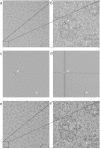A posteriori correction of camera characteristics from large image data sets
- PMID: 26068909
- PMCID: PMC4464200
- DOI: 10.1038/srep10317
A posteriori correction of camera characteristics from large image data sets
Abstract
Large datasets are emerging in many fields of image processing including: electron microscopy, light microscopy, medical X-ray imaging, astronomy, etc. Novel computer-controlled instrumentation facilitates the collection of very large datasets containing thousands of individual digital images. In single-particle cryogenic electron microscopy ("cryo-EM"), for example, large datasets are required for achieving quasi-atomic resolution structures of biological complexes. Based on the collected data alone, large datasets allow us to precisely determine the statistical properties of the imaging sensor on a pixel-by-pixel basis, independent of any "a priori" normalization routinely applied to the raw image data during collection ("flat field correction"). Our straightforward "a posteriori" correction yields clean linear images as can be verified by Fourier Ring Correlation (FRC), illustrating the statistical independence of the corrected images over all spatial frequencies. The image sensor characteristics can also be measured continuously and used for correcting upcoming images.
Figures




References
-
- Boyle W. S. & Smith G. E. Charge coupled semiconductor devices. At & T Tech. J. 49, 587 -+ (1970).
-
- Aikens R. S., Agard D. A. & Sedat J. W. Solid-state imagers for microscopy. Method Cell Biol. 29, 291–313 (1989). - PubMed
Grants and funding
LinkOut - more resources
Full Text Sources
Other Literature Sources

